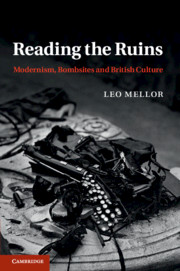Introduction
Published online by Cambridge University Press: 07 October 2011
Summary
[A]nd there he was, on the top of the hill, in the thick of the bombardment. A flapping gutter, glassless windows, an iron bedstead in a front garden the size of a tabletop. Half Paradise Piece had been torn up as if by bomb blasts: the children played about the steep slope of rubble; a piece of fire-place showed houses had once been there, and a municipal notice announced new flats on a post stuck in the torn gravel and asphalt facing the little dingy damaged row, all that was left of Paradise Piece.
Graham Greene, Brighton Rock (1938)In Greene’s description of a Brighton slum clearance scheme his central phrase –‘as if’ – is doing some stern and strenuous work. The preceding sentence has described a scene that could have been placed in any bombed city of the Spanish Civil War or drawn from the Japanese attacks on China, both conflicts underway when the novel was written, in 1937–8. If his disingenuous use of ‘bombardment’ as a way of describing a gale prepares expectations, then the template of the bombed metropolis as applicable to Britain is realised, partly as a form of foreboding and partly as an index of the details of destruction. All the items, disjunctions and classic tropes of the bombsite from that wartime literature to come are already present: household objects exposed violently to the world, disordered and incomplete remains, the absent glass as indicative of recent blast. Yet this is a scene of peacetime, the construction of a municipal utopia that will replace the actuality of squalor in the ironic Paradise Row. The real British bombsites, and Greene’s response to them, would follow only a few years later.
This book tracks how British culture feared, predicted, engaged with, portrayed and interpreted the bombsites of the Second World War; those spaces of destruction in the midst of British towns and cities caused by enemy attacks. Both the national psyche and the architecture of cities today still bear the marks of the Blitz of 1940/1, the ‘little Blitz’ of 1943/4 and the V1 rocket and V2 missile attacks. Over 50 per cent of buildings within greater London were damaged, with the totals in some boroughs being far higher. The book’s argument stems from a belief that such material conditions provide the subject of many works, whether overtly or implicitly. It also argues for the significance of the more abstracted value of these spaces (whether theological, metaphorical, allegorical) for the narratives and iconographies of British culture, both then and now.
- Type
- Chapter
- Information
- Reading the RuinsModernism, Bombsites and British Culture, pp. 1 - 10Publisher: Cambridge University PressPrint publication year: 2011

